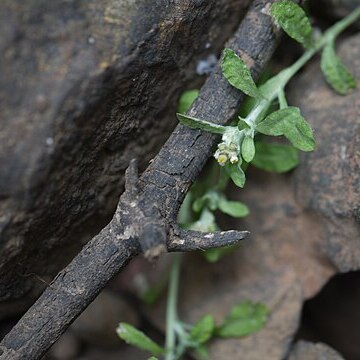Herbs, annual, dwarf, erect to decumbent, densely white lanate-tomentose, especially in upper part. Stems slender, simple or more commonly much branched, 8-25 cm tall, 0.5-1.5 mm in diam. Leaves sessile, grayish green, spatulate or oblanceolate-oblong, 1.5-4.5 cm × 3-8 mm, thinly appressed tomentose on both surfaces, margin and lower midribs sometimes flushed with purple, base narrowed, petioliform, margin wavy, apex obtuse and apiculate. Capitula 2-5, arranged in a spike to 2 cm, at tips of stems and branches, campanulate, 2.5-3 × 2-2.5 mm, densely lanate to 2/3 from base. Phyllaries 3-seriate, loosely imbricate, gradate, with pale brown apex, red-purple middle, and green base, these becoming brown when dry, elliptic-ovate or elliptic to linear-oblong, 1.6-2.2 × 0.5-0.8 mm, scarious, apex acute. Receptacle ca. 1.3 mm in diam., pitted. Outer florets many; corolla greenish yellow, filiform, ca. 1.2 mm, apex minutely 2-or 3-lobed, flushed with purple. Central florets 5 or 6, greenish yellow, tubular, ca. 1.5 × 0.5 mm, 5-toothed at apex, teeth flushed with purple. Stamens yellow, ca. 0.6 mm; anthers sagittate at base, connate into a tube around style. Style white, ca. 1.6 mm; style branches linear, flushed with orange-yellow; ovary olivaceous, cylindric, ca. 0.5 mm. Achenes pale brown, oblong-rectangular, ca. 0.5 mm, minutely punctuate. Pappus whitish, ca. 1.2 mm, bristles 5-8, distinct, falling separately. Fl. Jan-Apr. 2n = 14.
More
Annual herb, stems branched from the base, decumbent or erect, up to c. 250 mm long, thinly white-tomentose, leafy. Leaves up to 70 x 8 mm, but often much less than half that size, spathulate or oblanceolate, apex acute to obtuse, mucronate, both surfaces thinly grey-tomentose sometimes glabrescent. Heads c. 3 x 2.5 mm, in small stalked or sessile clusters racemosely arranged. Involucral bracts in 3 series, pellucid, pale buff, ageing palest brown, sometimes purplish around the stereome. Receptacle tuberculate. Flowers c. 150-225,140-220 ('female'), 4-6 ('bisexual'), in the proportion of at least 25:1. Achenes 0.5 mm long with duplex hairs. Pappus bristles of ('female') flowers scabridulous, of ('bisexual') flowers with more or less barbellate tips.
Decumbent or erect annual herb, up to 250 mm tall. Leaves spathulate or oblanceolate, thinly grey tomentose to glabrescent, not discolorous. Heads in small stalked or sessile clusters, racemosely arranged. Flowers pale buff, sometimes purplish tipped; August to October and in March.
A herb. It can be erect or lie over. It grows each year. It is 15-30 cm tall. It is branched from the base. It is covered with a white woolly covering. The leaves are narrowly oval.
Like G. confine but flowerheads ± racemose, involucral bracts with translucent tips and pappus ± monomorphic.


